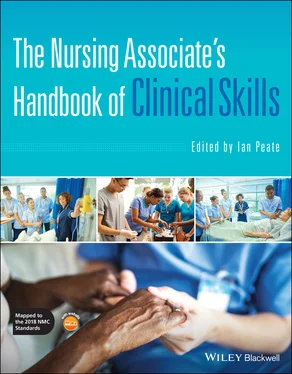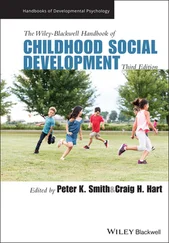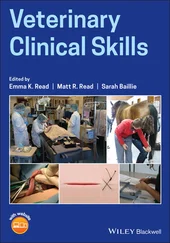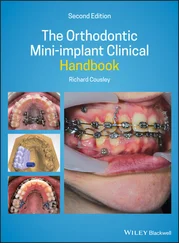The Nursing Associate's Handbook of Clinical Skills
Здесь есть возможность читать онлайн «The Nursing Associate's Handbook of Clinical Skills» — ознакомительный отрывок электронной книги совершенно бесплатно, а после прочтения отрывка купить полную версию. В некоторых случаях можно слушать аудио, скачать через торрент в формате fb2 и присутствует краткое содержание. Жанр: unrecognised, на английском языке. Описание произведения, (предисловие) а так же отзывы посетителей доступны на портале библиотеки ЛибКат.
- Название:The Nursing Associate's Handbook of Clinical Skills
- Автор:
- Жанр:
- Год:неизвестен
- ISBN:нет данных
- Рейтинг книги:4 / 5. Голосов: 1
-
Избранное:Добавить в избранное
- Отзывы:
-
Ваша оценка:
- 80
- 1
- 2
- 3
- 4
- 5
The Nursing Associate's Handbook of Clinical Skills: краткое содержание, описание и аннотация
Предлагаем к чтению аннотацию, описание, краткое содержание или предисловие (зависит от того, что написал сам автор книги «The Nursing Associate's Handbook of Clinical Skills»). Если вы не нашли необходимую информацию о книге — напишите в комментариях, мы постараемся отыскать её.
The Nursing Associate’s Handbook of Clinical Skills
The Nursing Associate’s Handbook of Clinical Skills
The Nursing Associate's Handbook of Clinical Skills — читать онлайн ознакомительный отрывок
Ниже представлен текст книги, разбитый по страницам. Система сохранения места последней прочитанной страницы, позволяет с удобством читать онлайн бесплатно книгу «The Nursing Associate's Handbook of Clinical Skills», без необходимости каждый раз заново искать на чём Вы остановились. Поставьте закладку, и сможете в любой момент перейти на страницу, на которой закончили чтение.
Интервал:
Закладка:
Therapeutic Nurse–Patient Relationship
Establishing positive and trusting therapeutic relationships with patients has long been recognised as an essential component of nursing practice and is important for effective care (Freshwater 2007; Mirhaghi et al. 2017). A therapeutic relationship such as this is defined by Feo et al. (2016) as a helping relationship that is based on mutual trust and respect; the nurturing of faith and hope; being sensitive to self and others and assisting with the satisfaction of the patient's physical, emotional and spiritual needs. This type of nursing involves understanding the true meaning of a situation, especially when it is not obvious or expected (Freshwater 2007). Successful interaction of focusing, knowing, anticipating and evaluating are skills used to build and maintain a trusting relationship (Feo et al. 2017).
Blue Flag
 Maintaining trust and confidence with the patient is an ongoing process that ensures the preservation of humanity during the delivery of care (Mirhaghi et al. 2017) which is viewed as an important prerequisite to facilitating a patient‐centred approach (Feo et al. 2016).
Maintaining trust and confidence with the patient is an ongoing process that ensures the preservation of humanity during the delivery of care (Mirhaghi et al. 2017) which is viewed as an important prerequisite to facilitating a patient‐centred approach (Feo et al. 2016).
Knowing the Patient
Getting to know the patient within the context of his/her specific illness and the context of his/her lives is considered by Dewing et al. (2014) as two types of knowing: the physical and psychological knowing. The physical knowing relates to the patient’s responses, physical function and body type, whereas the psychological knowing reflects the patient’s feelings, perceptions, expectations and beliefs. These will determine the patients’ own health beliefs, including their responses to illness, future life events and experiences.
Knowing the patient is vital in nursing; the nursing associate might state that we ‘know the patient very well’, but what does this really mean? What do we know and how do we know it? Several theories within the literature (Carper 1978; Watson 1985; Swanson 1991) have explored this knowledge for nursing practice, and it is reported that as such a situation as this ‘knowing’ cannot be based on formal scientific knowledge alone. Therefore, knowledge must be seen in another dimension associated with action and decision‐making and is referred to as ‘patterns of knowing’ (Carper 1978). Carper’s (1978) work sets out to bring together all the ways of knowing that are pertinent to nursing, integrating both practical and theoretical knowledge. Conducting a seminal piece of work, Carper (1978) explores the sources that nurses use to develop knowledge and beliefs about their practice and patient care by describing four patterns of knowing: empirical, aesthetic, personal and moral.
The first of Carper’s (1978) four patterns, empirics, refers to the science of nursing, and it is empirical, factual and descriptive in nature. This type of knowing allows the nursing associate to acquire both objective information regarding the patient’s condition and personal information concerning thoughts, feelings and experiences. The second is aesthetics; this refers to the art of nursing. Here, Carper (1978) reflects upon empathy as an important element of aesthetic knowing, suggesting that when a nursing associate learns to empathise, the different perspective of the patient life becomes apparent. The third relates to personal knowledge, and this is concerned with knowing, encountering and actualising of the individual self and in some respects relates to emotional intelligence and can be acquired through the therapeutic use of self (Currid & Pennington 2010).
Yellow Flag
 Knowing the patient in relation to their specific illness and the context of their lives is essential; ‘knowing’ will reflect the patient’s feelings, their perceptions, expectations and also their beliefs. This will establish the patient’s own health beliefs as well as how they may respond to illness, future life events and experiences.
Knowing the patient in relation to their specific illness and the context of their lives is essential; ‘knowing’ will reflect the patient’s feelings, their perceptions, expectations and also their beliefs. This will establish the patient’s own health beliefs as well as how they may respond to illness, future life events and experiences.
Defined as the ‘ability to recognise the meaning of emotions and their relationships and to use them as a basis of reasoning and problem‐solving’ (Mayer et al. 2001, p. 234), emotional intelligence is not always easy to translate. To be emotionally intelligent is generally described as a core aptitude related to one’s ability and capacity to reason with one’s emotions, especially in relation to others (Freshwater & Stickley 2004, cited in Williams 2015), which might suggest that nursing associates may possess the knowledge and skills but lack the ability to transmit them, and for a successful nurse–patient relationship, a balance of both would seem essential. This will be discussed further within this chapter.
The final of Carper’s (1978) four patterns of knowing is concerned with ethics. This focuses on the moral knowledge of the nurse, more specifically, a sense of knowing what is right and wrong for the patient. Every nursing associate will possess their own set of personal ethics and morals which they live by. Within healthcare practices, nursing associates should recognise healthcare dilemmas and make good judgements and decisions based on their values whilst keeping within the laws that govern them (Östman et al. 2019). Carper (1978) acknowledges that these patterns of knowing are not mutually exclusive, and nurses are seen to use attributes of all four patterns to successfully deliver patient‐centred care.
Incorporating Carper’s (1978) patterns of knowing, Johns (2000) suggests guided reflection as an addition pattern of knowing. The use of reflecting on experience as a means of enhancing clinical practice stems from the work of Schön (1983). Reflective and critical thought can help reason prejudices ensuring a growing awareness through reflective critical thought with regards to the nature of knowledge so not to assume things are true when they simply are not (Rolston et al. 2016). Benner (1984) points out that not all knowledge embedded in expertise can be captured in theory and furthermore believes that nurses need emotional space to think and feel about their practice. Reflective practice allows the nursing associate to explore the emotions that engaged or involved them in the situation, in the first place. Reflection can be described as the ability to explore one’s own actions, thoughts and feelings and think purposefully to gain new insights, ideas and understanding (Rolston et al. 2016).
Following Carper (1978), further theories have focused on how nurses go about gathering information to get to know the patient. In brief, Watson’s (1985) Transpersonal Caring theory indicated that nurses gain insight into a patient’s response to illness through a relationship exemplified by respect, compassion and support, pointing out the critical link between a deep connection with the patient and the nurse’s knowing, mirroring features of the therapeutic nurse–patient relationship. This is reinforced in Swanson’s (1991) theory of caring, where the dimensions of knowing are defined further to include avoiding assumptions, cue seeking and engagement of self, alluding to features of emotional intelligence.
Touch Point
Carper’s ( 1978 ) four patterns of nursing knowledge:
Personal knowing
Refers to the knowledge of ourselves, what we have seen and experienced. This type of knowledge comes through the process of observation, reflection and self‐actualisation. As we know ourselves, we are able to establish authentic, therapeutic relationships.
Читать дальшеИнтервал:
Закладка:
Похожие книги на «The Nursing Associate's Handbook of Clinical Skills»
Представляем Вашему вниманию похожие книги на «The Nursing Associate's Handbook of Clinical Skills» списком для выбора. Мы отобрали схожую по названию и смыслу литературу в надежде предоставить читателям больше вариантов отыскать новые, интересные, ещё непрочитанные произведения.
Обсуждение, отзывы о книге «The Nursing Associate's Handbook of Clinical Skills» и просто собственные мнения читателей. Оставьте ваши комментарии, напишите, что Вы думаете о произведении, его смысле или главных героях. Укажите что конкретно понравилось, а что нет, и почему Вы так считаете.












